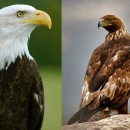These guidelines were developed by the U.S Fish and Wildlife Service to advise landowners, land managers and others who share public and private lands with bald eagles about when and under what circumstances the protective provisions of the Bald and Golden Eagle Protection Act may apply to their activities. The guidelines are intended to help people minimize such impacts to bald eagles, particularly where they may constitute disturbance which is prohibited by the Bald and Golden Eagle Protection Act.
Publication date
Type of document
Guidance
Media Usage Rights/License
Public Domain
Program
Species
FWS Focus


